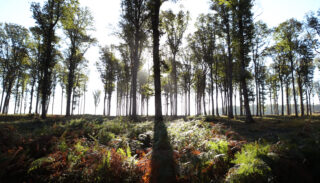Gazeteer of France’s great oak woods – Saint-Palais, a treasure trove for coopers
29 October 2019
Published in October 2018, the book The oak in majesty, from forest to wine highlights the concept of forest terroir: a specific soil, aspect, and rainfall, as well as a particular exposure to sunlight, to which should be added the species or variety of tree, the density of plantation, as well as average age, all of which will influence the grain and quality of the wood. The value of a mature high forest will thus depend on both the terroir and in the way in which it has been “led,” as French winegrowers say, or managed, in the words of the forester.
The book, fully illustrated with photographies, compile, through a gazeteer with a lot of details about geography, mesoclimate and history, a list of twenty-six beautiful oak wood forests, as the forest of Saint-Palais.
This is a little-known, but truly exceptional forest. Located in the Cher, the 1,929 hectares (4,767 acres) of Saint-Palais may pale in comparison with the gigantic Orléans forest, a little farther north, but this national forest’s composition of oak at 86%, the majority sessile with some common, as well as 9% beech, positions it among the most remarkable. The 807 ha (1,994 acres) of the “forest massifs and rivers of the Pays-Fort” are moreover classified as Zone Natura 2000. The ONF take care to fell only the excess, that is to say, 5 to 6 cubic meters per hectare (70–85 cubic feet per acre) and per annum, representing in total 10,500 cubic meters (370,000 cubic feet approx.). “The oaks felled are 180, sometimes even 230 years old in the ageing plots,” Thierry Gautrot, ONF officer for Bourges, observes.
These islands of old wood include some in which a few trees are left to die naturally in order to preserve biodiversity and offer a natural habitat for birds and insects. Natural regeneration is always preferred and frequent cuts, every eight or ten years depending on the age of the oaks, progressively allow more sunlight to filter to the ground and new seedlings to grow. Composed of some 138 plots, with an average surface of 14 ha (34.5 acres), this Atlantic forest is nearing the “end of conversion.” In forestry parlance, this corresponds to the transition from coppiced wood to even-age high forest. It is an operation that takes about a century and a half, so since 1847 for Saint-Palais. It is a forest that sees few visitors save for the ramblers from Bourges and Henrichemont, who appreciate its beauty.
Find out the entire gazeteer of France’s great oak woods, and much more, in The oak in majesty, from forest to wine written by Sylvain Charlois and Thierry Dussard.







